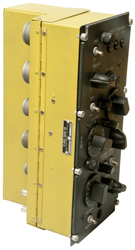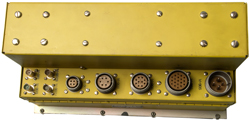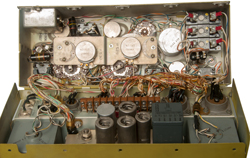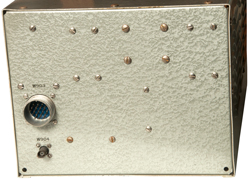AN/ARR-26 Sonobuoy Bathythermograph Receiver
© Brooke Clarke 2021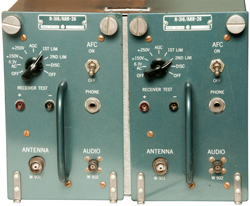 |
 |
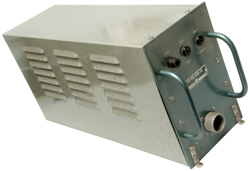 |
Description
AQA-1 Indicator Group
R-316 Receiver
PP-468 Power Supply
C-610 Control
C- 1414 Control
MT-685 Dual Receiver Mount
AT-209 Antenna
AM-1007 Audio Frequency Amplifier & MT--1437 Mounting
Manuals
Aircraft
Sonobuoys
Photos
Patents
Related
References
Links
Background
I've been interested in Sonobuoys for some time. I recently got a SSQ-53A DIFAR sonobouy and started looking into what equipment the operator had on the aircraft. Note that the CRT-1 sonobuoy receiver just fed into headphones. Compared to the modern frequency and bearing waterfall displays they were in a very primitive state.
The AQA-1 YouTube video shows a small control (C-1414) that has two 16-position channel selector switches and a few other controls and indicators for the R-316 receiver. The C-610 Control that's part of this ARR-26 has controls for both receivers and in addition has interphone controls.
I'm trying to learn about the introduction of the waterfall display, but technical details are few are far between. I have found a number of patents where the phrase "complex waveform" is used. These are listed on the SSQ-53A web page under Audio Analysis Patents.
A Bathythermograph measures the temperature of the ocean v. depth. This is very important to determine how sound travels underwater.
Description
AQA-1 Indicator Group
This sonobuoy receiver was part of the AQA-1 Sonobuoy Indicator Group. The display is a CRT which can give bearing and/or distance information. No waterfall display.
YouTube:U.S. Navy Sponobuoy Indicator Group AN/AQA-1 Anti-submarine Warfare film51114, 17:50 -
The AQA-5 is a chart recorder (Wiki) that displays frequency, bearing angle & TBD waterfall displays.
The AQA-7 replaced the chart recorder with a computer screen CRT display.
YouTube:Finding Submarines by P-3 Orion, Sonobuoys AN/AQA-5 Acoustic Charts Recorder Moffett Field Museum -8, 1:16 -
R-316 Receiver
The ARR-26 uses two identical R-316 receivers mounted in a single case so two sonobuoys can be monitored at the same time. Since the AQA-1 has four parallel channels most/some aircraft may have had two ARR-26 receiving systems.
Frequency
162.25 - 173.50 MHz. on 16 Channels (1st Generation Frequency Channels).
Modulation
Both FM (for the audio from the sonobuoy) and AM maybe for something to do with the bathythermograph?.
Each receiver has two outputs, one audio and the other video. The electronics at the back of the MT-685 dual receiver case is a video amplifier.
PP-468 Power Supply & MT-1026 Mounting
See: Fig 1 & Fig 2
Inputs: 110 - 120 VAC, 320 - 1760 Hz, <400 VA & 24 - 29 VDC, 7 - 250 Watts
Outputs: 150 VDC, 150 VDC Adjustable & 250 VDC (Not sure if the 110 - 120 VAC is used in the receiver)
C-610 Control
This control may contain an interphone amplifier since it has controls for controlling an interphone.
See: Fig 3 through Fig 8
The control shown in the AQA-1 YouTube video is small and only controls the ARR-26 pair of receivers. This C-610 control has additional functions connecting it with the Aircraft Interphone Communications system (AAFradio: The Forgotten element - Interphones)
C-1414 Control
This only controls the dual receivers, no interphone capability and so much smaller.
MT-685 Dual Receiver Case & MT-1028 Mounting
See: Fig 9 through Fig 15 for the R-316 receiver and the MT-685 dual case.
At the back of the MT-685 dual case there is a dual channel video amplifier associated with the directional video signal (not the audio output).
AT-209 Antenna
From the manual these appear to be 1/4 wave whips, probably centered at 167.78 MHz so about 16.7" long. The back side is a coax connector. The metal skin of the aircraft is the RF ground. There are two antennas in the ARR-16, one for each receiver offering better signal/noise than using a 2-way splitter and one antenna.
AM-1007 Audio Frequency Amplifier & MT--1437 Mounting
Manuals
NAVWEPS 16-30ARR26-501, Operator's manual
NAVWEPS 16-30ARR26-502, Handbook, Service Instructions, Radio Receiving Set AN/ARR-26, and, Radio Receiving Set AN/ARR-2A,
Supersedes NAVAIR 16-30APR26-502, Dated 1 May 1957
1 Aug 1962
Aircraft
Sonobuoy/Bathythermograph Receiver; manufactured by Texas Instruments; used in A-1 Skyraider (Wiki, mostly experimental (Air Vectors)), P-2 Neptune (Wiki, Air Vectors), P-5 Marlin flying boat (Wiki), S-2 Tracker (Wiki, Air Vectors) Z-1 Blimp (Wiki), ZPK Blimp (Wiki) (Designation-Systems: Airborne Radio Receivers)
AF-2S Guardian (Wiki (1945 - 1955), Air Vectors) (AF-2S_Guardian_SAC_-_15_February_1952.pdf): AN/ARR-31 or ARR-26 & 16 each SSQ-2 SonobuouysSonobuoys
The name for the ARR-26 includes Bathythermograph which must be the SSQ-36.
SSQ-15 Range only (sends out pings every 5 seconds)
SSQ-20 DIFAR
SSQ-2b non-directional (Explosive type)
Photos
Fig 1
Fig 2

Fig 3
Fig 4
Fig 5
Fig 6
Fig 7
Fig 8
Fig 9
Fig 10
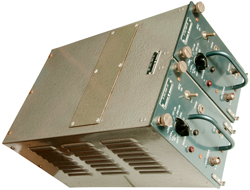
Fig 11

Fig 12
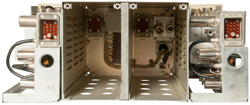
Fig 13
Fig 14
Fig 15
Patents
7986585 Reception of uplink data from sonobuoys, Donato M. Russo, Ronald Buratti, Navy, 2011-07-26, - lowers BER on digital data from sonobuoy to aircraft.
Related
Sonobuoy - R-1170/ARR-52A 32 Channel Sonobuoy Receiver
CRT-1 Sonobuoy - ARR-3 6 or 12 Channel (Color) Sonobuoy Receiver
Torpedoes, Mines, Depth Charges
Submarines
GEO_ID - TRC-3, PEWS, USQ-42, Turd
GSQ154 - All GSQ-154
GSQ160 - Frequency Disconnect -GSQ-160, USQ-46, TS-2963, PP-6446 - TCw - cylindrical module pinouts.
GSS26 - AN/GSS-26 minimal info
Intrusion Alarm Patents
USQ_Rx - Igloo White, USQ-42, USQ-46 details,
PSR-1 - now on it's own page (July 2007)
Modular Outdoor Intrusion Sensors (REMBASS?)
Astronomy - UFOs - Richard Muller Physics Lecture 11 - Waves 1
Radiosonde - PIBAL Theodolite - The weather stations lifted by Pilot Balloons have a very strong similarity to sonobuoys.
References
Links
PRC68, Alphanumeric Index of Web pages, Contact, Products for Sale
Page Created 2021 Aug 16

